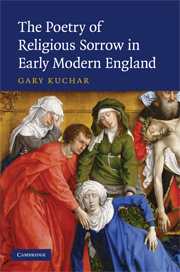Book contents
- Frontmatter
- Contents
- Acknowledgments
- Abbreviations and notes on texts
- Introduction: Of Sighs and Tears
- Chapter 1 The poetry of tears and the ghost of Robert Southwell in Shakespeare's Richard II and Milton's Paradise Lost
- Chapter 2 The poetry of tears and the metaphysics of grief: Richard Crashaw's “The Weeper”
- Chapter 3 The poetry of tears and the metaphysics of grief: Andrew Marvell's “Eyes and Tears”
- Chapter 4 Sad delight: Theology and Marian iconography in Aemilia Lanyer's Salve Deus Rex Judaeorum
- Chapter 5 Petrarchism and repentance in John Donne's Holy Sonnets
- Chapter 6 John Donne and the poetics of belatedness: Typology, trauma, and testimony in An Anatomy of the World
- Conclusion
- Index
- References
Chapter 4 - Sad delight: Theology and Marian iconography in Aemilia Lanyer's Salve Deus Rex Judaeorum
Published online by Cambridge University Press: 22 September 2009
- Frontmatter
- Contents
- Acknowledgments
- Abbreviations and notes on texts
- Introduction: Of Sighs and Tears
- Chapter 1 The poetry of tears and the ghost of Robert Southwell in Shakespeare's Richard II and Milton's Paradise Lost
- Chapter 2 The poetry of tears and the metaphysics of grief: Richard Crashaw's “The Weeper”
- Chapter 3 The poetry of tears and the metaphysics of grief: Andrew Marvell's “Eyes and Tears”
- Chapter 4 Sad delight: Theology and Marian iconography in Aemilia Lanyer's Salve Deus Rex Judaeorum
- Chapter 5 Petrarchism and repentance in John Donne's Holy Sonnets
- Chapter 6 John Donne and the poetics of belatedness: Typology, trauma, and testimony in An Anatomy of the World
- Conclusion
- Index
- References
Summary
A majority of the texts we have examined thus far either focus on, allude to, or parody Mary Magdalene – the Magna Pecatrix and Beata Dilectrix. This focus on an important female saint makes clear that the early modern grammar of religious melancholy is often construed as “feminine.” Throughout the literature of tears tradition, the ability to weep and the modes of pneumatic knowing revealed in and through weeping are thought to be “feminine” gifts. In this chapter, I would like to examine what is at stake in this gendering by making explicit the feminization of tears that has thus far remained relatively implicit. I will do this by examining what is arguably the most thoughtful, and certainly the most politically charged, early modern representation of godly sorrow as “feminine,” namely Aemilia Lanyer's Salve Deus Rex Judaeorum. More precisely, I will consider how Lanyer grounds both her poetic and priestly authority, as well as the Virgin Mary's priestly authority, on the early modern practice of figuring divine sorrow as feminine.
In a recent summary of Aemilia Lanyer's well-documented efforts to represent women as possessing priestly authority, Micheline White observes that in Salve Deus Rex Judaeorum “the Countess of Cumberland exercises the healing power of St. Peter's keys … the Countess of Cumberland and her daughter are ‘shepherdesses’ who heal and feed Christ's ‘flock,’ and [other] virtuous women are authorized to anoint themselves with ‘Aaron's oil’ and feed each other with the Word”.
- Type
- Chapter
- Information
- The Poetry of Religious Sorrow in Early Modern England , pp. 124 - 150Publisher: Cambridge University PressPrint publication year: 2008



